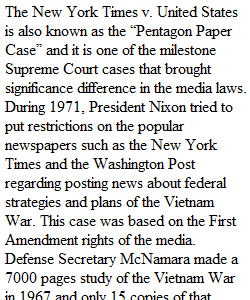


Q Mass Media Law Case Briefs: You will be assigned cases from the list of cases that correspond to each chapter. Some cases are major turning points in case law and others are important because of a specific element. Your primary information should come from the textbook BUT you should supplement that with library and Internet research. Please provide a typed brief that will be distributed to the class. A brief is a summary and analysis of the case prepared for use in classroom discussion. It is a set of notes, presented in a systematic way, in order to sort out the parties, identify the issues, ascertain what was decided, and analyze the reasoning behind decisions made by the courts. It should include: 1. Facts: Write a brief summary of the facts as the court found them to be. Eliminate facts that are not relevant to the court’s analysis. 2. Procedural History: What court authored the opinion: The United States Supreme Court? The California Court of Appeal? The Ninth Circuit Court of Appeals? (Hint: Check under the title of the case: The Court and year of the decision will be given). 3. Issue: What is the question presented to the court? Usually, only one issue will be discussed, but sometimes there will be more. What are the parties fighting about, and what are they asking the court to decide? 4. Rule(s): Determine what the relevant rules of law are that the court uses to make its decision. These rules will be identified and discussed by the court. 5. Application/Analysis: This may be the most important portion of the brief. The court will have examined the facts in light of the rule, and probably considered all “sides” and arguments presented to it. How courts apply the rule to the facts and analyze the case must be understood in order to properly predict outcomes in future cases involving the same issue. What does the court consider to be a relevant fact given the rule of law? How does the court interpret the rule? Summarize the court’s rationale in your own words. If you encounter a word that you do not know, use a dictionary to find its meaning. 6. Conclusion: What was the final outcome of the case? In one or two sentences, state the court’s ultimate finding. What was the court’s reasoning? 7. Concurring/Dissenting Opinion: You don’t need to spend too much time on this part other than the pinpoint the concurring or dissenting judge’s main point of contention with the majority opinion and rationale. 8. Implications of the court’s decisions (why it is important)
View Related Questions